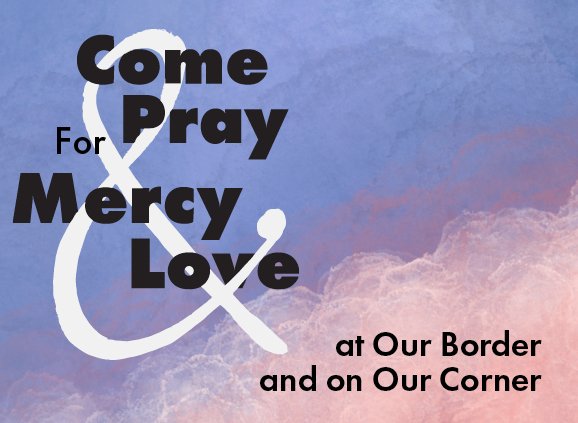
- Education Forums
A Letter from the Rector: Praying for Love & Mercy, at our Border and on our Corner

Dear Trinity Church and friends,
Grace and Peace to you from God in Christ.
This Sunday we will meet Jesus in a weary and lonely moment, struggling to reconcile another rejection. As he turns toward Jerusalem and the suffering of the cross, he calls to one in the crowd, saying, “Follow me.”[i] The prospective disciple replies, “Lord, first let me go and bury my father.”[ii] Instead of affirming this one for professing Jesus as “Lord,” or lending them mercy or grace in their grief, Jesus responds curtly: “Let the dead bury their dead; but as for you, go and proclaim the kingdom of God.”[iii]
We encounter this difficult Gospel lesson as we grapple with renewed attention to the suffering of detainees at our southern border, as well as the perilous journeys migrants undertake as they flee violence and oppression in their countries of origin. These issues point us to the underlying racism giving rise to such horrors, and that racism, these sufferings, and those journeys became powerfully personalized in the Julia Le Duc photograph of Óscar Alberto Martínez Ramírez and his two-year-old daughter, Valeria, laying face down and dead in the muddy waters of the Rio Grande. Tall grass on the Matamoras bank slightly obscures the image’s foreground, and a blue beer can floats to left of the child, whose head and shoulders are tucked inside her father’s shirt. The photograph evokes heavy, heavy grief, and the story leading to its moment only deepens its sadnesses.
Drawing on AP reports, Globe correspondent Amanda Kaufman explains that the twenty-five-year-old Mr. Ramirez “decided to brave the fast-moving waters of the Rio Grande with his daughter, Valeria, because he was frustrated that he and his family were unable to present themselves to US authorities for asylum. After Martinez set his daughter on the US side of the river, he went back for his wife, Tania Vanessa Avalos, according to [the AP photographer who captured the image]. But when the toddler saw her father swim away, she jumped back in the water after him. Martinez was able to turn back and grab Valeria, but the current swept them both away,”[iv] all as their family watched.
In the ninth chapter of Luke’s Gospel, the tension between Jesus and this grieving member of the crowd witnesses consequential differences in their respective visions: while this prospective disciple’s vision reaches only the burial of his dead father, Jesus’ vision reaches the very fulfilment of time. That is, while Jesus seeks the reconciliation of the whole cosmos – all the living and the dead – this follower seeks the understandably nearer accomplishment of honoring his beloved. Importantly, these are not differences of alignment or trajectory, but of horizon, and, given that continuity, the hardness of Jesus’ response offends us readers.
Though in alignment along the same continuum, the Ramírez family’s deaths present our nation the opposite challenge. That is, who would protest the unfettered, vulnerable love animating a child to leap into danger; the utter devotion sending a father after her; or the overwhelming grief that such powerful loves could lead to death? Surely that answer is none of us. However, how many of us struggle to confront the incrementalism of the racist culture and policies leading to that horrific moment? How many of us struggle to sustain our attention and risk our position to confront the racism on our corner, with the same clarity this photograph prompts us to decry it at our border? How many of us desire the reconciliation of the whole cosmos, but without having to reconcile our more immediate and personal complicities in that which separates us from God and one another?
I find my earnest desire to memorialize this father and child conveniently appeals to that which is familiar to me, and my identities as a father and a son allow me to cast myself as a member of the same human family as those who suffer and those who have died. Though this is true and real (powerfully, in fact), I am also aware that prioritizing these familiarities aligns me with the victims of the terror at our border, specifically, and the victims of racism, broadly, and excuses me from confronting my necessary complicities as a white man in this particular time and place. Lingering in my grief excuses me from the more difficult and demanding labor of confronting the differences between my immediate family and the Ramírez family: my power, my privilege, my comfort, and my role in the racist culture required to sustain them. Such empathy is a delaying tactic richly layered with love – “Lord, first let me go and bury my father” – but it is a delaying tactic, nonetheless.
Though Jesus’ great weariness asks, Is there no rest for one who seeks righteousness? he still delivers the Kingdom answer: a clear and cold, No. In fact, if we are to share God’s hope for the world, then each of our assumptions must be tested, and every one of our intuitions must be interrogated: is it kind? Is it just? Is it right? … over and over and over again, until the fulfilment of time, until all people have been reconciled to God and to one another. Even as we aim for the joy of Easter, then, Jesus calls us to turn toward the challenges of the cross.
Within twenty-four hours of publishing Le Duc’s photograph, the media’s coverage shifted to last night’s Democratic debate, confirming how easily our society’s deeply ingrained racism allows the national attention to shift away from the suffering of brown and black people. Thereby, the world’s indulgence in its distractions challenges our commitments to hold fast our loves and kindnesses and mercies. As Christians and as members of Trinity Church, we must stay on the righteous path, realizing that the tendernesses and horrors we have now seen in the Rio Grande point directly to those in our Boston streets.
In that spirit, I invite you to gather this Saturday at 8:00AM in the Trinity Church sanctuary. We will present to God all these complexities: praying peace for the dead and comfort for the grieving, confessing sins and asking for wisdom. When the corporate service concludes, the church will remain open for individual prayer.
Steeling for the hard work and turning toward hope, let us pray:
O God, you made us in your own image and redeemed us through Jesus your Christ: Look with compassion on the whole human family; take away the arrogance and hatred which infect our hearts; break down the walls that separate us and unite us in bonds of love; work through our struggle and confusion to accomplish your purposes on earth; that, in your good time, all people may be reconciled to you and to one another. Amen.
Peace be with you,
Morgan
The Rev. Morgan S. Allen
Rector
- January 2024
- December 2023
- November 2023
- October 2023
- September 2023
- June 2023
- May 2023
- April 2023
- March 2023
- February 2023
- January 2023
- December 2022
- November 2022
- October 2022
- June 2022
- May 2022
- April 2022
- March 2022
- February 2022
- January 2022
- November 2021
- October 2021
- September 2021
- August 2021
- July 2021
- June 2021
- May 2021
- April 2021
- March 2021
- February 2021
- January 2021
- December 2020
- November 2020
- October 2020
- September 2020
- August 2020
- July 2020
- March 2020
- February 2020
- January 2020
- December 2019
- November 2019
- October 2019
- September 2019
- August 2019
- July 2019
- June 2019
- May 2019
- April 2019
- March 2019
- February 2019
- January 2019
- December 2018
- November 2018
- October 2018
- September 2018
- August 2018
- July 2018
- June 2018
- May 2018
- April 2018
- March 2018
- February 2018
- January 2018
- December 2017
- November 2017
- October 2017
- September 2017
- July 2017
- May 2017
- April 2017
- March 2017
- February 2017
- January 2017
- December 2016
- November 2016
- October 2016
- September 2016
- August 2016
- May 2016
- April 2016
- March 2016
- February 2016
- January 2016
- December 2015
- November 2015
- October 2015
- October 2013
- September 2013
At "Educational Forums," enrich your spiritual journey by exploring our resources including videos of lectures, essays by priests, and other pieces about our faith, our church, and what it means to be a disciple of Jesus in the 21st century.


Comments